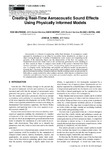Creating Real-Time Aeroacoustic Sound Effects Using Physically Derived Models
| dc.contributor.author | Selfridge, R | |
| dc.contributor.author | Moffat, David | |
| dc.contributor.author | Avital, EJ | |
| dc.contributor.author | Reiss, JD | |
| dc.date.accessioned | 2020-10-16T12:55:38Z | |
| dc.date.available | 2020-10-16T12:55:38Z | |
| dc.date.issued | 2018-07 | |
| dc.identifier.issn | 1549-4950 | |
| dc.identifier.other | 7/8 | |
| dc.identifier.uri | http://hdl.handle.net/10026.1/16546 | |
| dc.description | date-added: 2017-07-04 11:12:05 +0000 date-modified: 2018-08-23 12:24:57 +0100 read: 1 bdsk-url-1: https://doi.org/10.17743/jaes.2018.0033 | |
| dc.description.abstract |
Aeroacoustics is a branch of engineering within fluid dynamics. It encompasses sounds generated by disturbances in air either by an airflow being disturbed by an object or an object moving through air. A number of fundamental sound sources exist depending on the geometry of the interacting objects and the characteristics of the flow. An example of a fundamental aeroacoustic sound source is the Aeolian tone, generated by vortex shedding as air flows around an object. A compact source model of this sound is informed from fluid dynamics principles, operating in real-time, and presenting highly relevant parameters to the user. A swinging sword, Aeolian harp, and propeller are behavior models are presented to illustrate how a taxonomy of real-time aeroacoustic sound synthesis can be achieved through physical informed modeling. Evaluation indicates that the resulting sounds are perceptually as believable as sounds produced by other synthesis methods, while objective evaluations reveal similarities and differences between our models, pre-recorded samples, and those generated by computationally complex offline methods. | |
| dc.format.extent | 594-607 | |
| dc.language.iso | en | |
| dc.publisher | Audio Engineering Society | |
| dc.title | Creating Real-Time Aeroacoustic Sound Effects Using Physically Derived Models | |
| dc.type | journal-article | |
| dc.type | article | |
| plymouth.author-url | https://www.webofscience.com/api/gateway?GWVersion=2&SrcApp=PARTNER_APP&SrcAuth=LinksAMR&KeyUT=WOS:000447290400006&DestLinkType=FullRecord&DestApp=ALL_WOS&UsrCustomerID=11bb513d99f797142bcfeffcc58ea008 | |
| plymouth.issue | 7/8 | |
| plymouth.volume | 66 | |
| plymouth.publication-status | Published online | |
| plymouth.journal | Journal of the Audio Engineering Society | |
| dc.identifier.doi | 10.17743/jaes.2018.0033 | |
| plymouth.organisational-group | /Plymouth | |
| plymouth.organisational-group | /Plymouth/Faculty of Arts, Humanities and Business | |
| dc.rights.embargoperiod | Not known | |
| rioxxterms.versionofrecord | 10.17743/jaes.2018.0033 | |
| rioxxterms.licenseref.uri | http://www.rioxx.net/licenses/all-rights-reserved | |
| rioxxterms.type | Journal Article/Review |


